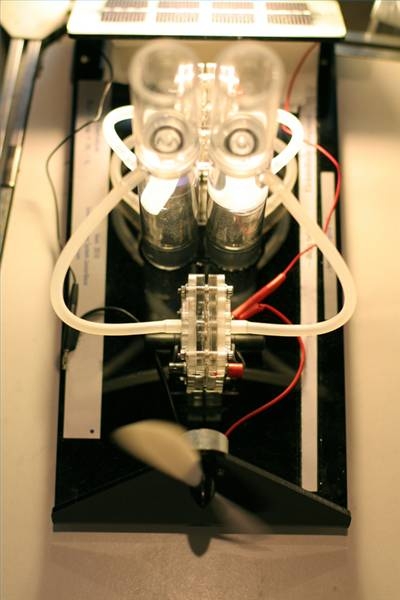
With continually rising oil prices and growing concern for the global environment, more focus is being given to the hydrogen fuel cell as a replacement for burning fossil fuel. A hydrogen fuel cell is basically a battery that uses hydrogen to generate electrical power. Unlike other types of batteries, the hydrogen fuel cell receives a constant supply of fuel, and does not have to be continually replaced. Allowing for eventual erosion of encasements, hydrogen fuels cells themselves can conceivably last a lifetime. The most popular and promising type of hydrogen fuel cell is the polymer exchange membrane fuel cell, or PEMFC. These fuel cells are being tested and run every day all over the world, and they will continue to be improved upon to power a growing number of vehicles, homes, and businesses each year.
The PEMFC has a relatively simple yet effective design. Compressed hydrogen gas is pulled into the fuel cell where the negative pole, called the anode, is located. The compression forces the gas through a catalyst. While passing through the thin platinum coating of the catalyst, the negatively-charged electrons and positively-charged ions of the hydrogen molecules are separated. The electrons pass through the anode and travel toward the positive pole of the fuel cell, called the cathode. It is the movement of these electrons that produces the electricity. As this is happening, the ions are attracted to oxygen molecules that are being forced through the cathode. When the oxygen molecules meet with the hydrogen electrons and ions, water is created. Water or water vapor is harmlessly released from the cell, and is its only waste product. One single hydrogen fuel cell produces only a small amount of voltage. For use in vehicles and to power homes, single fuel cells are stacked together and encased to form a larger functioning unit.
Research on hydrogen fuel cells has been ongoing, and improvements will continue to be made. As a promising replacement for burning fossil fuel, hydrogen fuel cells will continue to be at the forefront of alternative fuel research. The process for extracting pure hydrogen from water or other substances is where a lot of research is being focused. It takes electricity to extract hydrogen, and this electricity is usually produced by burning fossil fuel. To make a hydrogen cell more cost effective and environmentally friendly than burning fossil fuel, methods of hydrogen extraction must continue to be refined.